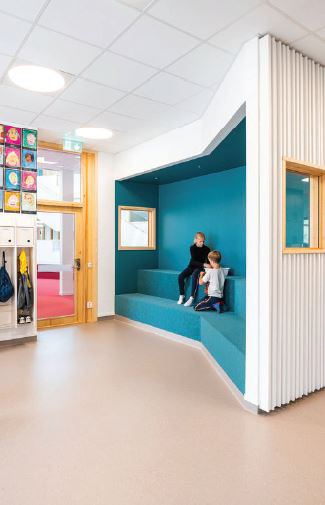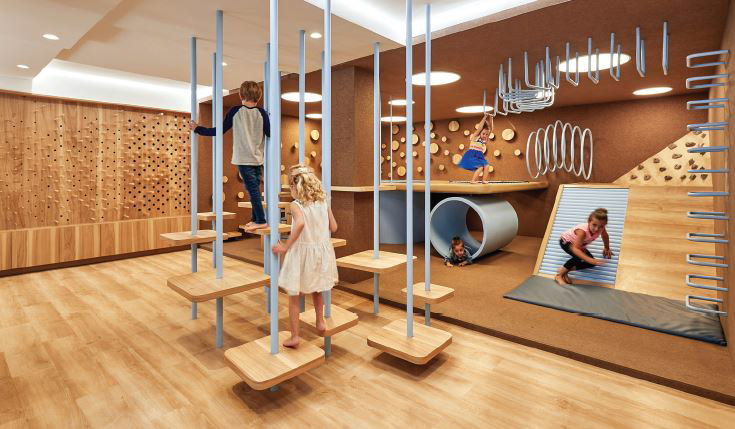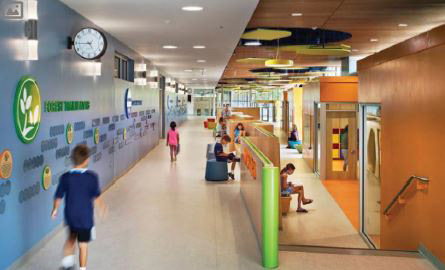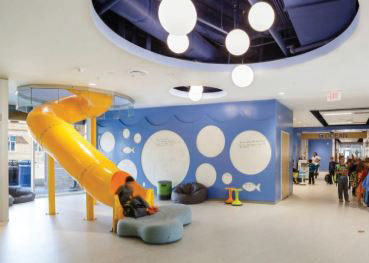Pre-Design
Precedent Studies:
Skälby School and Preschool
Location: Sollentuna, Sweden
Type: General Education
Description: The Skälby School was rebuilt to replace the older smaller school at the site. The redesign celebrates light, is stimulating to the students, and creates a much more exciting learning environment. The classes are located on the exterior of the building so that they receive the most day-lighting. Outside the classrooms are fl ex spaces for the students to work and play at. Beyond the fl ex spaces is the “shared heart” of the school where all the students can gather.
Type: General Education
Description: The Skälby School was rebuilt to replace the older smaller school at the site. The redesign celebrates light, is stimulating to the students, and creates a much more exciting learning environment. The classes are located on the exterior of the building so that they receive the most day-lighting. Outside the classrooms are fl ex spaces for the students to work and play at. Beyond the fl ex spaces is the “shared heart” of the school where all the students can gather.
Nía School
Location: Mexico City, Mexico
Type: General Education
Description: The goal of the design was to engage and encourage students to be excited to learn through design. The school supports students ages two through eight in two classrooms and a variety of flexible spaces.
Type: General Education
Description: The goal of the design was to engage and encourage students to be excited to learn through design. The school supports students ages two through eight in two classrooms and a variety of flexible spaces.
Discovery Elementary School
Location: Virginia, United States
Type: General Education
Description: The Discovery School in Arlington, Virginia was the first school to be designed in the 21st century. The purpose of the school was to prove how a newly designed school can support the way students learn. Discover Elementary School was the first school to receive the LEED Zero Energy certification.
Type: General Education
Description: The Discovery School in Arlington, Virginia was the first school to be designed in the 21st century. The purpose of the school was to prove how a newly designed school can support the way students learn. Discover Elementary School was the first school to receive the LEED Zero Energy certification.
Old Donation Elementary School
Location: Virginia, United States
Type: Gifted Education
Description: The Discovery School in Arlington, Virginia was the fi rst school to be designed in the 21st century. The purpose of the school was to prove how a newly designed school can support the way students learn. Discover Elementary School was the first school to receive the LEED Zero Energy certifi cation.
Type: Gifted Education
Description: The Discovery School in Arlington, Virginia was the fi rst school to be designed in the 21st century. The purpose of the school was to prove how a newly designed school can support the way students learn. Discover Elementary School was the first school to receive the LEED Zero Energy certifi cation.

Skälby School and Preschool

Skälby School and Preschool

Nía School

Discovery Elementary School

Discovery Elementary School
Design Considerations
Educational Experience
Flexibility
Sensory Engagement
Physical Activity
Flexibility
Sensory Engagement
Physical Activity
Design Development
Presentation Space:
By making use of the twenty-five percent of typically unused corridor space, the design can further enhance the quality of the student’s performance by moving learning outside the classroom. The hallway has the opportunity to provide for breakout spaces for groups, reading nooks for individual use, or room for the whole classroom to use.
By designing a variety of spaces in the hallway, each student is encouraged to find their favorite place. Teachers have the option to adapt their classes to the spaces provided to them. For example, multiple classes can gather in the hallways and perform a short play or give a presentation here.
The Presentation space is meant to build the student’s confidence and encourage students to practice speaking in front of others. Right behind the presentation wall are the bathrooms and a space that could be used as a quick costume change.
Hallway Perspective:
The design is meant to encourage physical activity throughout the day outside the classroom which improves the student’s concentration, improves their motivation and engagement, and improves their overall performance. The stairs are located in the center of the building so that students are continually going up and down the stairs throughout the day. The hallways are designed so that students have the opportunity to climb on the built-in furniture between classes.
Breakout spaces are created so that students have the opportunity to bring their studies outside of the classroom. The students are still visible to the teachers through the storefront windows along the front of the class.
Hallway Elevation 1:
“Corridors take up 25-30% of a school’s total square footage."
Ferebee-Hope will have a variety of educational enclaves such as reading nooks and interactive maps to engage the students upon entering the classroom.
Hallway Elevation 2:
“Corridors take up 25-30% of a school’s total square footage."
Ferebee-Hope will have a variety of educational enclaves such as reading nooks and interactive maps to engage the students upon entering the classroom.
